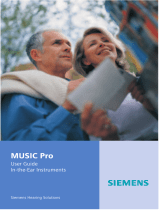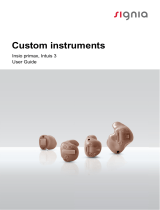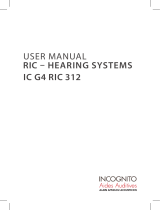Page is loading ...

CENTRA
TM
User Guide
Behind-the-Ear System
s

2
Congratulations !
As the owner of a new hearing system, you may once again
enjoy the sounds of your environment and conversation with
your family and friends.
These instructions as well as support from your hearing
instrument specialist will help you understand how your new
hearing system works. In this guide, you’ll find instructions
about insertion, removal and use of your CENTRA
TM
hearing
system. There are also tips and information on proper hand-
ling, cleaning, care and changing of the batteries. In addi-
tion, a troubleshooting section is offered for your reference.
Your hearing improvement with a hearing system depends
on the fit of the hearing instruments, the type and degree
of hearing loss, and proper diagnostic testing. Of course,
a hearing system cannot restore normal hearing, and not
everyone will benefit equally.
More than 80 percent of individuals with a hearing loss have
a hearing loss in both ears. Studies show that even when a
hearing loss is worse in one ear, most people will benefit
from wearing two instruments.
Remember, a hearing system consists of finely-tuned devices
that have been specially designed and expertly adjusted for
your individual needs. Proper care and handling will ensure
the best possible performance of your CENTRA hearing
system.

3
Contents
Page
Your CENTRA BTE (behind-the-ear) hearing system
- CENTRA S and CENTRA S VC 4
- CENTRA P and CENTRA HP 5
- CENTRA SP 6
Battery insertion and removal 7
Battery compartment door lock 10
Inserting and removing your CENTRA BTE 11
Turning your CENTRA BTE on and off 12
e2e wireless
TM
14
Using the program button 16
Using the directional microphone system 18
Audio input 20
Using the telephone 22
Maintenance and care 24
Important notes 25
Troubleshooting tips 26

4
Your CENTRA S and S VC BTE*
hearing system
CENTRA S VCCENTRA S
s
s
g
k
h
h
j
a
j
g
f
k
* BTE – Behind-the-ear
Features
1. Ear hook
2. Microphone openings
3. Program button
with ON/OFF function
(only CENTRA S)
4. Volume control (only
CENTRA S VC)
5. Cover for programming
socket
6. Battery compartment
with ON/OFF function
7. Color-coded typeplate
red = right instrument
blue = left instrument
8. Audio input
a
d

5
CENTRA HPCENTRA P
Your CENTRA P and HP BTE
hearing system
Features
1. Ear hook
2. Microphone openings
3. Program button
with ON/OFF function
4. Volume control
5. Cover for programming
socket
6. Battery compartment
7. Color-coded typeplate
red = right instrumen
blue = left instrument
8. Audio input
For optimum fitting, CENTRA P instruments are specially
designed for both the left and right ears. In addition, they
are color-coded for your convenience to keep them easily
apart.
s
g
k
h
j
a
d
f
s
g
k
h
j
a
d
f

6
Your CENTRA SP BTE hearing
system
Features
1. Ear hook
2. Microphone openings
3. Program button
with ON/OFF function
4. Volume control
5. Cover for programming
socket
6. Battery compartment
7. Color-coded typeplate
red = right instrument
blue = left instrument
8. Audio input
CENTRA SP
a
j
g
d
f
k
s
h

7
Battery insertion and removal
Handling the battery
Remove the tab on your battery
only when you are ready to use it.
Inserting the battery
Open the battery compartment
with your fingernail as shown in
the illustration.
Swivel open the battery compart-
ment door, if not already open.
Insert a proper sized battery so
that the "+” symbol on the battery
matches the "+” marked on the
battery compartment.
Three useful tips:
• The positive (+) side of the battery is always the
smooth side. You can recognize the negative (-) side
by the colored ring.
• Always keep spare batteries with you.
• If you think you cannot change the battery by yourself,
ask someone to help you: a family member, friend or
your hearing instrument specialist.

Low battery indicator
Your hearing system may be programmed to inform you
when the battery should be replaced for best system perfor-
mance. You may hear an intermittent series of beeps and/or
experience low amplification power or volume. Change the
battery when either of these occurs.
When using a remote control
If you have an ePocket
TM
remote control, you can check the
battery status using the "data read out” function. (See the
ePocket user guide for more information).
8
Close the battery compartment
by gently pressing the bottom of
the door upward with your finger
tip. Do not force the door shut. If
it does not close easily, check if
the battery was inserted properly.
When the battery door is comple-
tely closed, your hearing instru-
ment is ready for use.
Removing the battery
In case the battery does not come
out, lightly tap the system or care-
fully push the
battery out with a
pencil as shown.

9
Caution:
Keep batteries and instruments away from the reach of
small children.
Batteries can be harmful if swallowed.
If swallowed, consult a physician or a hospital immedia-
tely.
Change the batteries when any of the following occur:
- Volume becomes softer or weak.
- You hear a battery signal beep.
- You see empty battery status on
the display of your ePocket.
Do NOT throw used batteries into household trash.
Return them to your hearing instrument specialist
for environmentally correct disposal.

10
Battery compartment door lock
Your instrument is equipped with a
battery compartment door lock to
prevent the unintentional removal
of the batteries.
To lock the battery compartment,
open the compartment door to the
first stop. Push the slide to the
right with a suitable tool.
To unlock the battery compart-
ment, open the compartment door
to the first stop. Push the slide to
the left with a suitable tool.
If necessary, your hearing instru-
ment specialist can further instruct
you on the use of this feature.

11
Inserting and removing
your CENTRA BTE
Make sure that your hearing
instrument is turned off. Hold the
earmold between your thumb and
index finger and insert it carefully
into your ear canal. You may find
it helpful to pull your ear slightly
upward or to the back. Gently
work the earmold into its proper
position by adjusting it until it is
firmly seated in your ear. Once
inserted, you should be able to
feel if the ear mold is placed cor-
rectly. Next, place your hearing
instrument behind your ear and
turn it on.
Tip:
Practice inserting and removing
your hearing instrument correctly.
An easy way to practice is to sit
down at a table. Place a mirror in
front of you and prop your elbows
on the table so you can guide
your hands easily and safely. This
will help you stay relaxed and
comfortable while you practice.

12
Turning your CENTRA BTE
ON and OFF
Via the battery compartment
Your CENTRA hearing system turns on automatically when a
battery is inserted and the compartment door is completely
closed.
To turn OFF
Press the battery compartment in
the rear down to the first stop to
turn the hearing instrument OFF.
To turn ON
Fully close the battery compart-
ment to turn the hearing instru-
ment ON.

13
Your hearing instrument specialist
can also program your hearing
system to be turned ON and OFF
using the program button.
Via the push button
To turn your hearing instrument OFF, press and hold the pro-
gram button for approximately 2 seconds.
To turn your hearing instrument ON again, press and hold the
program button for approximately 2 seconds.
Please note that when you turn your hearing instrument OFF
using the program button, you must wait approximately 10
seconds for the instrument to reset before you can turn it
back ON again using the program button.
Check with your hearing instrument specialist which ON/OFF
function your hearing system is equipped with.
Power-on delay
Your hearing instrument is equipped with a "power-on delay"
feature. This feature delays sound from entering your hearing
instrument when it is first turned on, so that you may insert
the hearing instrument into your ear without experiencing
unpleasant feedback (whistling). The "power-on delay" can
be activated by your hearing instrument specialist.

14
e2e wireless
TM
for CENTRA hearing systems
Unique to your CENTRA hearing system is the e2e (ear-to-ear)
wireless technology. This wireless functionality...
... automatically adjusts both of your hearing instru-
ments simultaneously to different listening situations.
... allows use of accessories including the ePocket
(bi-directional remote control) function.
... provides synchronization of the settings in the system.
If you change the volume or program on one hearing
instrument, the other is automatically adapted.
Your hearing instrument specialist can activate or deactivate
the e2e wireless functionality of your hearing system. The
ePocket function can be activated or deactivated separately.
Note:
The performance of the e2e wireless could be affected by
electro-magnetic interferences, such as a computer monitor or
halogen lamp systems controlled by a switching power supply.
Move away from the source of interference if you experience
difficulty.

15
Wireless remote control –
ePocket
(accessory)
The e2e wireless function of your
CENTRA hearing system supports
ePocket, the bi-directional remote
control from Siemens. With ePocket,
you can change the program and
volume of your hearing system
and read out the system settings.
For further information on ePocket,
contact your hearing instrument
specialist or refer to the ePocket
user guide.
ePocket
TM
accessory
for CENTRA hearing systems
Note:
In case another person’s remote control unit (RCU) interferes
with your hearing aid, please return your RCU and hearing
aid to the service department for change of the transmission
key.
During the use of the wireless link while the instrument is
operated in telephone coil mode, pulsing noise may be heard
due to pick-up of the transmission signal by the hearing aid
telephone coil. Please use remote control in telephone coil
mode only with a distance greater than 10 cm.

16
Using the program button
How to select the programs
Your CENTRA hearing system
offers up to four hearing pro-
grams for specific listening envi-
ronments. They change the cha-
racteristics of the sound coming
through the hearing system. Se-
lect a program using the program
button of your hearing aid or by attaching an audio shoe.
Each time you press the program button, your hearing sys-
tem switches to the next program, confirming each change
with a beep. The number of beeps you hear coincides with
the selected program: one beep for the first program, two
beeps for the second program etc. When you attach an audio
shoe, the hearing system automatically switches to program 4.
The program button can be programmed for special
functions:
Audio shoe: Is the audio shoe attached, you can use the
program button to change between the different audio shoe
modes (only audio shoe, mix mode of audio shoe and micro-
phone or only microphone mode).

17
Telephone coil: When you hold a telephone receiver to your
CENTRA hearing instrument, the telephone program Auto-
Phone is automatically activated by the magnetic field of the
receiver.
Ask your hearing instrument specialist about these functio-
nalities and he will program your CENTRA hearing system to
your individual needs.
1
2
3
4
Description of the hearing situation
Hearing program
Note:
For e2e wireless function:
If you are wearing two hearing instruments, the program
will be changed on both instruments at the same time.
Audio shoe
AutoPhone
Mode
Functionality

18
Using the directional
microphone system
Your CENTRA hearing system has a directional microphone
system, which can be programmed to your individual needs.
It can be set to an automatic mode so the CENTRA hearing
system automatically adjusts the microphone system from
omni-directional to directional mode and back, depending
on the hearing situation.
For example:
A typical situation for the directional mode is a face-to-face
conversation in a noisy environment.
A typical situation for the omni-directional mode is when you
are in more quiet environments and want to hear the sounds
around you.
Your hearing instrument specialist will program the opera-
tion of the directional microphone system to function either
automatically or in conjunction with the program button
based on your individual hearing requirements and preferen-
ces. If the directional microphone system is not programmed
to function automatically, your hearing instrument specialist
can instruct you on its use.

19
Using the volume control
All CENTRA hearing systems have manu-
al volume control, except the CENTRA S.
In general, volume control of CENTRA
hearing systems is fully automatic and
there is no need to manually adjust the
volume. Should you prefer manual volu-
me control, however, CENTRA hearing
systems can be programmed for manual
adjustment.
Rotate the wheel
upwards to increase
volume. Rotate it down
to decrease volume.
For manual adjustment, rotate the wheel-shaped volume
control with your index finger to select the desired listening
volume (up for louder, down for softer).
If your hearing system is equipped with a warning tone for
volume control limits, once it is heard, adjusting the volume
control further in that direction will have no effect.
Learning function
CENTRA hearing instruments memorize changes made in
volume control settings. They are evaluated, averaged, and
automatically applied. This means that over time your hea-
ring instrument automatically adapts to your preferences
regarding the volume setting for each program.
If your hearing system has not been programmed for manual
control adjustment, the volume will automatically adjust and
rotating the volume control wheel will have no effect.
Note:
With the ePocket remote control, volume settings can be
adjusted and memorized on all systems.
If you are wearing two hearing instruments, the volume
will be changed on both instruments simultaneously.

20
Audio input
Your hearing system is equipped with audio input capability.
This enables the connection between the hearing system and
accessories such as an FM system, tape recorder, television-,
or an infrared device. It can be useful for adults in difficult lis-
tening situations and for children in classrooms. Because the
sound is coming directly from the sound source to the hearing
system, the signal is clearer and unaffected by poor room
acoustics.
Note:
You can only use audio shoes designed exclusively for CENTRA
hearing systems.
Nib in the audio shoeSmall recess in the
hearing system housing
only CENTRA SP
Hearing system
Printed sign at
the inner side*
“F5” CENTRA S
“F5” CENTRA S VC
“F5” CENTRA P
“F5” CENTRA HP
“L6” CENTRA SP
* Which can be seen when looking from the top into the audio shoe.
/







